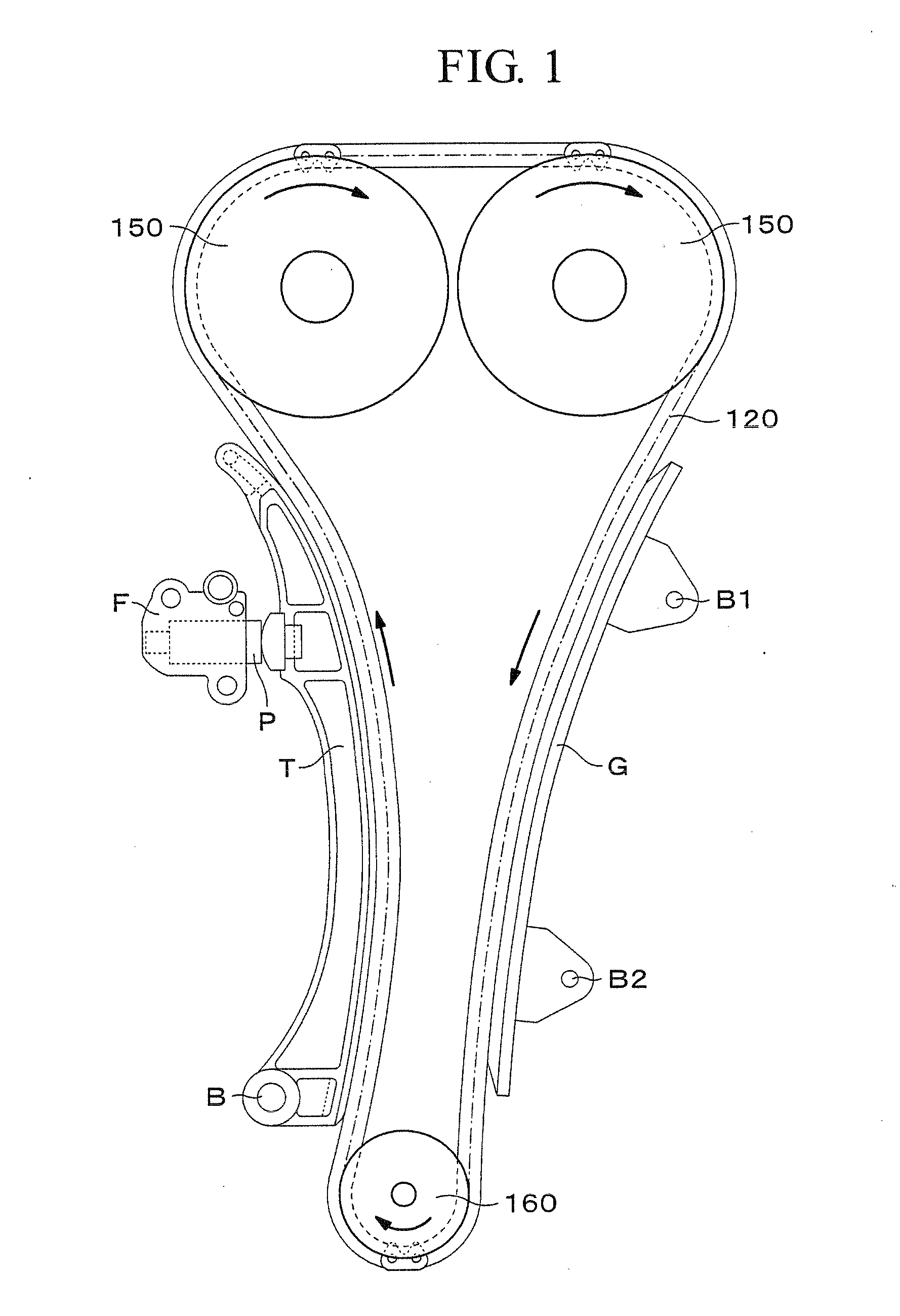Silent chain transmission system
a transmission system and chain technology, applied in the direction of driving chains, valve drives, gearing, etc., can solve the problems of increasing occupying an excessive amount of space, and not being able to maintain a uniform gap between the connecting pins, so as to reduce the space occupied by the sprocket, improve the ability of the chain transmission, and reduce the thickness and weight of the sprocket.
- Summary
- Abstract
- Description
- Claims
- Application Information
AI Technical Summary
Benefits of technology
Problems solved by technology
Method used
Image
Examples
first embodiment
[0053]As shown in FIGS. 2 through 4, the silent chain transmission system of the invention includes a chain 120 that is composed of alternating outer, or first, link rows and inner, or second, link rows, connected by connecting pins 121 and bushings 122, and a sprocket 110. The sprocket can be a driven sprocket 150 (FIG. 1) or a driving sprocket 160 (FIG. 1), and has a sprocket body 113 (FIG. 2) provided with sprocket teeth 111 on it outer peripheral surface thereof and flanges 112 on both sides of the sprocket body and extending outwardly at least beyond the roots of the sprocket teeth 11, for guiding the chain 120.
[0054]As shown in FIGS. 3 and 4, the chain 120 includes outer (first) link rows the first link rows, each composed of a pair of outer link plates 132 each having a pair of front and rear pin holes 133, and inner (second) link rows, each composed of a pair of inner link plates 142, each having a pair of front and rear bushing holes 143.
[0055]Each of the outer link plates ...
third embodiment
[0061]As shown in FIGS. 6 and 7, a silent chain transmission 300 according to the invention comprises a chain 320 whose outer, or first, link rows are flexibly connected to inner, or second, link rows. Each outer link row comprises a pair of outer link plates 332 having pin holes 333, and each inner link row consists of a single link plate 342 having pin holes 343. The outer link plates are connected by connecting pins 321, which are press-fit into holes 333 and extend rotatably through pin holes 343 in the inner link plates. The chain cooperates with a sprocket (not shown but similar to the sprocket in FIG. 2) having a sprocket body provided with sprocket teeth around the outer peripheral surface thereof and flanges on both sides for guiding the chain.
[0062]Except as described above, the structure and operation of the silent chain transmission of the third embodiment are substantially the same as the structure and operation of the first embodiment.
fourth embodiment
[0063]As shown in FIGS. 8 and 9, a sprocket 210 of a silent chain transmission according to the invention transmits power by engagement of its sprocket teeth 211 with the plate teeth 134 and 144 of the outer and inner link plates 132 and 142 of a chain 120.
[0064]Both sides of the sprocket 210 are provided with flanges 212 which extend beyond the roots of sprocket teeth 211 but not beyond their tips. That is, the diameter of each of flanges 212 is smaller than the diameter of an imaginary circle tangent to the tips of the sprocket teeth and centered on the axis of rotation of the sprocket. On the other hand, the diameter of each the flanges is greater than that of an imaginary circle tangent to the tips of the outer plate teeth 134 in a portion of the chain seated on the sprocket. Accordingly, widthwise movement of the outer link plates 132 is restricted to prevent the plate teeth 134 and 144 from disengaging from the sprocket teeth 111 by widthwise movement of the chain.
[0065]Becaus...
PUM
 Login to View More
Login to View More Abstract
Description
Claims
Application Information
 Login to View More
Login to View More - R&D
- Intellectual Property
- Life Sciences
- Materials
- Tech Scout
- Unparalleled Data Quality
- Higher Quality Content
- 60% Fewer Hallucinations
Browse by: Latest US Patents, China's latest patents, Technical Efficacy Thesaurus, Application Domain, Technology Topic, Popular Technical Reports.
© 2025 PatSnap. All rights reserved.Legal|Privacy policy|Modern Slavery Act Transparency Statement|Sitemap|About US| Contact US: help@patsnap.com



